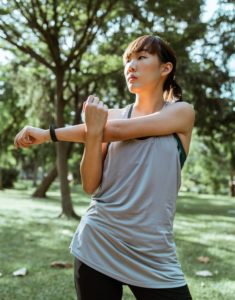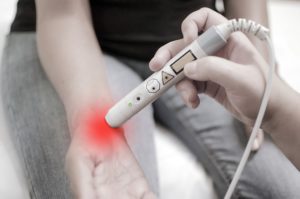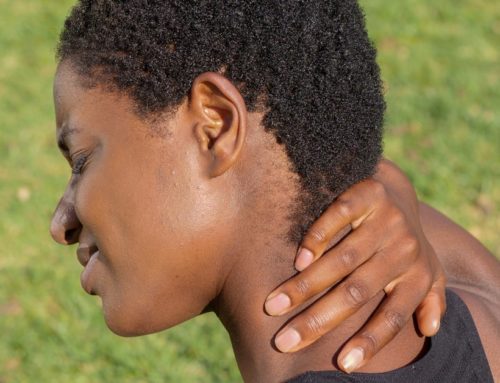If you have arthritis, your health care provider has probably told you that exercise can be beneficial. Moving more when your joints already ache can seem daunting. The good news is you can exercise with arthritis without being in horrible pain. Exercising on a regular basis will also reduce your pain and swelling, improve your balance and energize you. Ready to get started? Here are some tips on how to exercise when your joints hurt:

Start Slow
This one may seem like a no-brainer, but what you may not know is that even a little bit of exercise can be beneficial. It’s especially important to start slow if you’ve been sedentary for some time or if you struggle with balance.
Everyday activities that get you off the couch can be a great place to start—walking your dog once a day, raking leaves, or mowing the lawn are good examples of daily activities that are also a workout. Walking (even without a dog) is one of the most beneficial forms of exercise. It won’t strain your joints, but it will relieve stiffness, ease pain and improve mental health.
Forms of exercise that use slow, controlled movements are also useful for arthritis patients. Tai Chi and gentle yoga forms can improve your range of movement, ease pain and stiffness and improve balance. Let your instructor know about your arthritis so they can let you know which moves you might want to avoid.
It’s normal to feel a bit sore after exercising, especially if it’s been a while. You can tell you are overdoing it if your joints feel sore for longer than two hours after your exercise routine. Listen to your body and pull back a bit if this is the case. Never keep exercising if you feel a sharp pain or any pain that is different from your usual arthritis pain. This could be a sign of another problem, and you should talk to your doctor.

Use Heat and Ice
When you are working out with arthritis, heat and ice therapy can be your best friend. Apply a warm towel or heating pad to your sore joints for about twenty minutes before you plan to exercise. The heat increases circulation to the area and relaxes the joints and the muscles around them. Heat treatment can reduce stiffness and make it easier to work out.
After your workout routine, apply ice to your sore joints or take a cool shower or bath. Applying cold for twenty minutes will reduce and prevent swelling that could cause more pain. You can also use cold therapy on achy joints between workouts to minimize swelling.
Ask your doctor before using heat and cold therapy on your legs or feet if you have diabetes or conditions that impact leg circulation.

Warm-Up
In addition to literally warming up your joints, you’ll also need to do some movements to prepare your body for exercise. This is true for everyone, but it’s especially important for people with arthritis pain. Simple stretches and range of motion exercises will prepare your joints and muscles for a workout and prevent injury. Shoulder rolls, arm circles, and slowly marching while bringing your knee up as high as you can are examples of good warm-up exercises. You can talk to a fitness trainer or look online to find warm-up routines designed specifically for people with sore joints.

Focus on Low Impact Exercises
Low impact exercises are those that don’t jar your joints. Normally cartilage and fluids within the joints cushion and protect them from damage. In arthritis patients, especially those with advanced disease, the cartilage has deteriorated, and the fluid in the joint is not as slippery and cushioning as it used to be. This makes activities that put pressure on your joints painful. Luckily many enjoyable and effective exercises won’t hurt your joints. Swimming, water aerobics, bicycling, and using an elliptical machine are examples of low-impact exercises. All of these provide an effective aerobic workout.

Don’t Shun Strength Training
It might sound contrary to the above advice, but weightlifting and other forms of strength training won’t jar your joints in the same ways as jumping or running can. Strength training is one of the most beneficial forms of exercise for arthritis patients. It helps to strengthen your bones and your muscles and improve balance.
Start out with lightweight dumbbells (2-3 pounds for women and 5-8 pounds for men). If you can’t do twelve reps, then they are too heavy. If your arms don’t feel tired after twelve reps, then the weight is too light. Gradually increase the weight as needed, but remember that the number of reps you do is more important than lifting a heavyweight. Don’t strain or overexert yourself and avoid locking your knees and elbow joints.
Two to three sessions lasting twenty or thirty minutes is enough to make progress. You can start with a strength training session once a week and work your way up from there. Resistance bands and gym weight machines can be used in place of free weights. If you want to use free weights but have arthritis pain in your hands, strap-on weights that attach to your wrist will give you the same amount of resistance without requiring you to grip a free weight.
Always perform strength training exercises with a slow, controlled motion. Breath out as you lift and in as you lower. Try to rotate muscle groups, working the major muscles of your lower body one day and your upper body on a different day. Avoid over-the-shoulder exercises if you have arthritis pain in your upper body. Consulting with a licensed fitness trainer can help you design a program that will work for you.

The Takeaway
Exercise is beneficial for arthritis pain, and it can be done comfortably and safely. Here at Burkhart Chiropractic, we have years of experience caring for arthritis patients. We can provide treatments and lifestyle advice to help you be more active with less pain.





